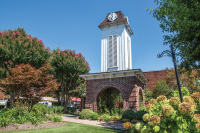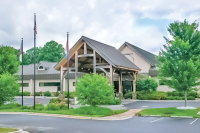Sowing the seed of learning: Elementary school garden serves as a conduit for science and life lessons alike
 Clad in his signature overalls, Joe Smiley leaned on his rake, taking in the tranquil late-summer scene: pie-pans strung among the corn stalks twisted in the breeze, daisies dipped ever so slightly under the weight of a welcome bee, a wheelbarrow gently rumbled its way down the garden path.
Clad in his signature overalls, Joe Smiley leaned on his rake, taking in the tranquil late-summer scene: pie-pans strung among the corn stalks twisted in the breeze, daisies dipped ever so slightly under the weight of a welcome bee, a wheelbarrow gently rumbled its way down the garden path.
But looks can be deceptive. This was merely the calm before the storm, Smiley warned with a grin, nodding toward the school doors as a wave of second-graders rushed out.
The Hazelwood Elementary School garden was about to explode with the energy of a packed football stadium celebrating a winning home-team touchdown.
“I call it controlled chaos,” said Smiley.
Smiley — or Farmer Joe as the kids know him — reached out and tousled a few heads as the kids crowded closer, awaiting marching orders for their weekly descent on the garden.
Farmer Joe explained that is was scavenger hunt day, setting off a contagious round of “yippees.”
Related Items
The Hazelwood school garden is an all-volunteer venture, now in its seventh year. A team of Haywood County Master Gardeners pays for all the supplies and takes on the toil of regular garden chores.
The kids make a noble stab at helping, but digging for worms and nibbling basil leaves is usually far more pressing than pulling weeds and deadheading spent blooms during their spin through the garden each week.
Still, the students have witnessed the work that goes into the garden, following the progression from seed to harvest.
The garden is planted each year by first-graders, who spend two months tending the seedlings before school lets out. When they return as second-graders after summer break, the garden they find is drastically different than the one they left in June.
“It was really, really surprising. We saw so many new things,” said second-grader Bianca Dietz. “There wasn’t corn, and now there’s corn.”
“I like how it changed so much,” said classmate Lucy Hill.
Now, as the gardening season comes to a close, they are sad the journey’s over.
Their final lesson will be saving seeds from their harvest to pass on to the next crop of first-graders come spring. And that offered a measure of solace: the seeds they grew will be the foundation for next year’s garden, just as it was for every grade that’s come before them.
Hazelwood Elementary is one of three schools in Haywood County with a garden run by the master gardeners. The other two are Junaluska and Riverbend elementaries.
Hazelwood Principal Wendy Rogers said the garden is an excellent engagement tool for students.
“It gives them hands-on, experiential learning,” Rogers said.
The garden is an ideal science laboratory, from learning about pollinators to the water cycle.
But it also teaches the concept of community. The potatoes students planted last spring were donated by the Haywood County Gleaners, a philanthropic initiative to reap the remnants of local farmers’ crops on behalf of local food charities that serve the needy. (see story page 40). The potatoes harvested from the school garden are then returned to the gleaners.
The students dug the potatoes their first week back from summer break, and those potatoes have become as legendary as any fisherman’s tale.
“They were huge, I mean gigantic,” said Lily Brown, holding out her hands as large as a basketball.
Last week, several master gardener volunteers were on hand to lead the students through the garden as they checked off their scavenger hunt list. They scouted the squash patch for the old-timey variety known as candy roasters, examined bean pods bursting from vines and stopped to smell the flowers — literally.
“It smells like syrup,” said Ty Gudger.
The official scavenger hunt list soon fell by the wayside, however, as more of a starting point or suggestion rather than a fast mandate.
“Look a lady bug!” called Piper Bumgardner.
“Snappy peas! Snappy peas!” hollered Stonewall Strickland.
“The mint leaves smell really good,” said Jayden Belue.
A group of children stopped under a sunflower and peered up at the head, lost in the revelation that the sunflower seeds they’ve all eaten are quite literally the seeds of a sunflower. They hesitated a moment when asked why none of them had grown a sunflower in their stomach before.
“They need soil and light to grow,” wagered Josie Ostendorff.
You could possibly swallow some dirt, but “you can’t swallow light,” concluded Jaelynn.
The garden is also a window into the natural world, whether it’s the owl decoys that keep crows at bay or the symbiotic role of beneficial insects.
The garden is also a certified Monarch Waystation, which means it’s well endowed with milkweed, the go-to food source for monarchs. The students are currently hatching monarch butterflies from cocoons in their classroom, also courtesy of the master gardeners. All the classes will gather outside for the butterflies’ release when the time comes and sing to help the butterflies light into the sky.
“They get so excited. It’s like they are giving birth,” Farmer Joe said.
As the garden session drew to a close last week, a trio of girls enamored with the soft, fuzzy leaves of Lamb’s Ear bid the plant farewell until next time, while a group on a worm expedition in the potato bed returned their squiggling finds back to the soil.
“They are all over the place, but as long as they are having fun,” said Betty Anne Buell, one of the master gardener volunteers carrying a clipboard. Buell said the most important seed the garden plants is the love of learning in students.
Rogers said the garden motivates students to find success in an endeavor, even if academics isn’t their strongest suit.
“It’s a continuous mindset of caring for something and watching it grow,” Rogers said.
Students can apply that life-lesson to their own work back in the classroom, Rogers said.
Farmer Joe has lead the school garden for seven years, but is passing the trowel to a fellow master gardener next year. Mike Robertson has been an apprentice under Farmer Joe for a few years, and is ready to take on the duty of garden headmaster.
“Earlier this year he said ‘It’s time to hang it up. It’s yours,’” Robertson recalled. “And I said ‘I’m ready to take it.’”
Robertson said the garden is intensely rewarding for the master gardeners who get to experience the wonderment and enthusiasm of seeing a garden through a child’s e,yes.
“They love doing this. The way they learn is hands on and they really respond to it. Never have I seen the light go on for somebody like it does with these kids,” said Robertson. “It’s something that’s going to carry with them for life.”









